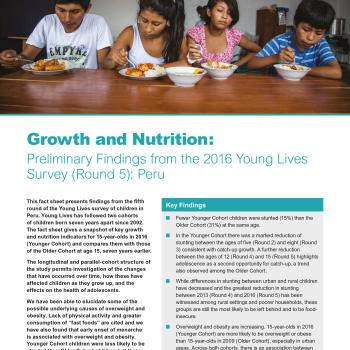
Round 5 Longitudinal Growth and Nutrition Fact Sheet
This fact sheet presents findings from the fifth round of the Young Lives survey of children in Peru. Young Lives has followed two cohorts of children since 2002. This fact sheet gives a snapshot of key growth and nutrition indicators for 15-year-olds in 2016 (Younger Cohort) and compares them with those of the Older Cohort at age 15, seven years earlier. The longitudinal and parallel-cohort structure of the study permits investigation of the changes that have occurred over time, how these have affected children as they grow up, and the effects on the health of adolescents. We have been able to elucidate some of the possible underlying causes of overweight and obesity. Lack of physical activity and greater consumption of “fast foods” are cited and we have also found that early onset of menarche is associated with overweight and obesity. Younger Cohort children were less likely to be stunted than Older Cohort children but there has been a parallel increase in overweight and obesity, primarily among urban and better-off families.
Key Findings:
Fewer Younger Cohort children were stunted (15%) than the Older Cohort (31%) at the same age. In the Younger Cohort there was a marked reduction of stunting between the ages of five (Round 2) and eight (Round 3) consistent with catch-up growth. A further reduction between the ages of 12 (Round 4) and 15 (Round 5) highlights adolescence as a second opportunity for catch-up, a trend also observed among the Older Cohort. While differences in stunting between urban and rural children have decreased and the greatest reduction in stunting between 2013 (Round 4) and 2016 (Round 5) has been witnessed among rural settings and poorer households, these groups are still the most likely to be left behind and to be food-insecure. Overweight and obesity are increasing. 15-year-olds in 2016 (Younger Cohort) are more likely to be overweight or obese than 15-year-olds in 2009 (Older Cohort), especially in urban areas. Across both cohorts, there is an association between early puberty and later obesity for girls, with increased risk of chronic diseases later in life. Compared with the Older Cohort at the same age, the Younger Cohort ate a slightly more diverse diet. Improvements were greatest in the rural areas and in poorer households.

Round 5 Longitudinal Growth and Nutrition Fact Sheet
This fact sheet presents findings from the fifth round of the Young Lives survey of children in Peru. Young Lives has followed two cohorts of children since 2002. This fact sheet gives a snapshot of key growth and nutrition indicators for 15-year-olds in 2016 (Younger Cohort) and compares them with those of the Older Cohort at age 15, seven years earlier. The longitudinal and parallel-cohort structure of the study permits investigation of the changes that have occurred over time, how these have affected children as they grow up, and the effects on the health of adolescents. We have been able to elucidate some of the possible underlying causes of overweight and obesity. Lack of physical activity and greater consumption of “fast foods” are cited and we have also found that early onset of menarche is associated with overweight and obesity. Younger Cohort children were less likely to be stunted than Older Cohort children but there has been a parallel increase in overweight and obesity, primarily among urban and better-off families.
Key Findings:
Fewer Younger Cohort children were stunted (15%) than the Older Cohort (31%) at the same age. In the Younger Cohort there was a marked reduction of stunting between the ages of five (Round 2) and eight (Round 3) consistent with catch-up growth. A further reduction between the ages of 12 (Round 4) and 15 (Round 5) highlights adolescence as a second opportunity for catch-up, a trend also observed among the Older Cohort. While differences in stunting between urban and rural children have decreased and the greatest reduction in stunting between 2013 (Round 4) and 2016 (Round 5) has been witnessed among rural settings and poorer households, these groups are still the most likely to be left behind and to be food-insecure. Overweight and obesity are increasing. 15-year-olds in 2016 (Younger Cohort) are more likely to be overweight or obese than 15-year-olds in 2009 (Older Cohort), especially in urban areas. Across both cohorts, there is an association between early puberty and later obesity for girls, with increased risk of chronic diseases later in life. Compared with the Older Cohort at the same age, the Younger Cohort ate a slightly more diverse diet. Improvements were greatest in the rural areas and in poorer households.

